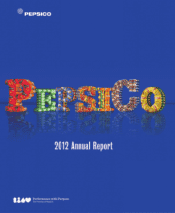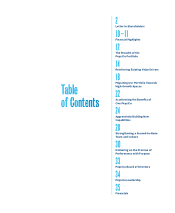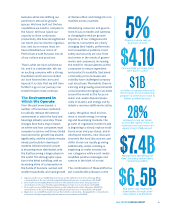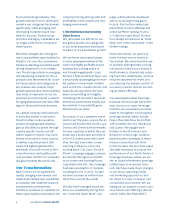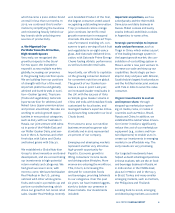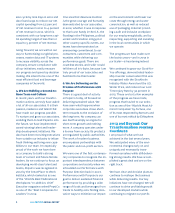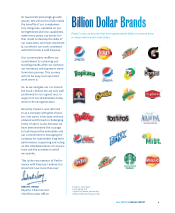Pepsi 2012 Annual Report Download - page 8
Download and view the complete annual report
Please find page 8 of the 2012 Pepsi annual report below. You can navigate through the pages in the report by either clicking on the pages listed below, or by using the keyword search tool below to find specific information within the annual report.6 2012 PEPSICO ANNUAL REPORT
for 24 percent of our net revenue;
in 2012, they represented 35
percent of our net revenue. And
over the long term, we are look-
ing to grow our business in these
markets at high single digits to low
double digits.
3. We Accelerated the Benets
of One PepsiCo
PepsiCo’s strength lies in the fact
that our portfolio is diverse, but
related. The convenient snack and
beverage businesses have high
levels of coincidence of purchase
and consumption and very high
velocities at the shelf. We believe
this portfolio complementarity pro-
vides a natural hedge, allowing us to
manage through individual category
issues and still deliver good returns.
Our portfolio provides us three ad-
ditional major benets.
First, cost leverage: We are an
important customer to key vendors
in the food and beverage space.
We have preferred partner status
with many of them, which allows us
to strategically make use of each
other’s supply chains and develop-
ment eorts to meaningfully reduce
our input costs while accessing their
best talent and advanced thinking.
Additionally, inside PepsiCo, across
businesses, we share infrastructure
including corporate functions, mas-
ter data and back oce processing,
further lowering our costs.
Second, capability sharing: Over
the past few years, we have harmo-
nized many of our processes, mak-
ing it easier to move talent across
the company—both businesses and
geographies. We are able to attract
world-class talent and give them
a truly diverse, but related set of
experiences, allowing us to build a
world-class workforce.
We “lift and shift” best practices
across the value chain. For exam-
ple, the expertise we have devel-
oped in increasing yields while
conserving water helps us get
more crop per drop in our agricul-
tural operations throughout the
world, be it potatoes or corn for
our snacks, or fruits and vegetables
for our juice business.
Because of the high coincidence
of consumption of our products,
we have developed a common con-
sumer demand framework under-
pinned by a global database, giving
us proprietary insights into food
and beverage occasions. This guides
our innovation actions at the global
and local level.
Third, commercial benets: As
the second-largest food and bever-
age business in the world and the
largest in the U.S., we are trac
generators and therefore viewed
as a critical growth driver by retail-
ers. Just in the U.S., we have nine
of the top 40 trademarks at retail,
more than any other food and bev-
erage company.
Retailers benet from our in-store
promotions that leverage power-
ful properties such as the National
Football League, Major League
Baseball and the National Hockey
League in the U.S.; talented soc-
cer players like Lionel Messi, who
appeared in both Pepsi and Lay’s
commercial activities globally; as
well as through mini-lms like the
“Bring Happiness Home” Chinese
New Year production that brought
together Lay’s, Tropicana and Pepsi
to deliver an emotional public ser-
vice message to Chinese consum-
ers—Go home to your families for
Chinese New Year. This lm gar-
nered more than 700 million views
in China alone.
All these activities increased co-
incidence of purchases between
beverages and snacks and our
healthy breakfast bundles, and in
2012, made us the second-largest
growth contributor in all measured
U.S. retail channels combined.
Foodservice customers are also
beginning to benet from the
power of PepsiCo’s portfolio: Taco
Bell in the U.S. is a case in point. For
more than 45 years, we have been
their beverage partner of choice.
Mountain Dew “Baja Blast,” a avor
developed exclusively for Taco Bell,
has been a best-selling trac driver
in its system since launch. In 2012,
building on this beverage relation-
ship, we partnered with Taco Bell
to introduce Doritos Locos Tacos,
a taco with a shell made from real
Nacho Cheese Doritos that has be-
come the restaurant’s biggest suc-
cess in its 50-year history. In nine
months alone, Taco Bell sold more
than 325 million Doritos Locos
Tacos—one of the most successful
new products in the foodservice
industry in 2012. In 2013, we expect
to continue building on this suc-
cess, with the launch of Cool Ranch
Doritos Locos Tacos. More impor-
tantly, we are innovating now on the
beverage front with the launch of
Mountain Dew “Baja Blast Freeze.”
The pairing of the Doritos and
Mountain Dew brands is a natural:
In the U.S. convenience channel,
Doritos is the number one salty
snack, while Mountain Dew is the
number one single-serve carbon-
ated soft drink.

